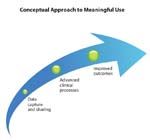Achieving Meaningful Use of Electronic Health Records for the Oncologist
In 2003, the Institute of Medicine (IOM) issued a report outlining key capabilities of an electronic health record.[1]
Interest in Electronic Health Records
In 2003, the Institute of Medicine (IOM) issued a report outlining key capabilities of an electronic health record.[1] The report described the interest of private and public entities in moving providers from paper-based records to electronic storage of health information. Rationales for this transition included quality improvement, greater patient safety, and control of escalating health care costs through improved efficiency. To help identify the desired core EHR system functionalities, the IOM committee formulated five criteria:
• Improvement in patient safety.
• Support for the delivery of effective patient care.
• Facilitation of the management of chronic conditions.
• Improvement in efficiency.
• Feasibility of implementation.
The core functionalities identified were:
• Health information and data.
• Results management.
• Order entry/management.
• Decision support.
• Electronic communication and connectivity.
• Patient support.
• Administrative processes.
• Reporting and population health management.
The report expected transition to take longer for physicians’ practices as compared with hospitals because of differences in the availability of financial resources for IT investment. As anticipated, adoption of EHRs by physician offices has been slow. Barriers to adoption have included cost, lack of financial return, and logistical challenges in implementing EHRs.[2] To address this problem, the American Recovery and Reinvestment Act (ARRA) of 2009 allocated approximately $19 billion to act as a financial incentive for physicians and hospitals to adopt EHRs.2

David Eagle, MD
Compared with recent physician incentive programs such as the Physician Quality Reporting Initiative (PQRI), the ARRA incentive program provides more generous financial rewards. For physicians satisfying requirements in 2011 or 2012, the payments can be as high as $18,000 per physician. The payments gradually decline over the following 4 years. Penalties will then follow beginning in 2015. However, for practices to receive the financial incentive, they must do more than use an EHR in their practice. Rather, they must demonstrate that they are achieving “meaningful use” of their EHR by meeting multiple criteria.
Our practice, Lake Norman Oncology, became among the first oncology practices in the country to achieve meaningful use. Our practice adopted an EHR in 2010. In April, 2011, with the support of our EHR vendor, Altos Solutions, we were able to complete the attestation process shortly after CMS opened its portal for submission of data. Subsequently, the practice has received payment in the amount of $18,000 per physician.
Here, we provide an overview of the criteria for meaningful use, the challenges most offices can expect to encounter in achieving these criteria, and the process of attestation itself. The rules and regulations for meaningful use attestation are complex. This article is primarily intended to provide an introduction to the topic and to discuss how meaningful use of EHRs fits into the broader evolution of our health system.
Achieving Meaningful Use of Electronic Health Records

Thomas R. Barr, MBA
To achieve meaningful use in the first phase of EHR roll-out, the ARRA outlined three broad categories of activities that must be engaged in. First, physician offices must use a certified EHR in a “meaningful” manner, such as e-prescribing. Second, the EHR must be used to exchange health information electronically. Third, providers must submit clinical quality measures. This initial phase of meaningful use focuses on data capture and sharing. In the future, it is expected that meaningful use will require advanced clinical processes, followed later still by demonstration of improved outcomes.[3]
To achieve meaningful use in 2011, eligible professionals must use an EHR platform that has been certified by CMS for the incentive program. Criteria for meaningful use must be satisfied for a continuous 90 day period. The meaningful use criteria include fifteen “core” and ten “menu set” items. All core criteria must be met. The core criteria are:
1. Computerized provider order entry (30%).
2. E-prescribing. (40%)
3. Report of ambulatory clinical quality measures.
4. Implementation of one clinical decision support rule.
5. Electronic copy of patients’ health information provided per patient request. (50%)
6. Clinical summaries provided for patients for each office visit. (50%)
7. Drug-drug and drug-allergy interaction checks performed.
8. Demographics recorded. (50%)
9. Updated problem list of current diagnoses maintained. (80%)
10. Current medication list maintained. (80%)
11. Current medication allergy list maintained. (80%)
12. Changes in vital signs recorded and charted. (50%)
13. Smoking status for patients older than 13 years recorded. (50%)
14. Capability to exchange key clinical information among providers of care and patient-authorized entities electronically.
15. Protection of electronic health information.
In addition, eligible professionals must satisfy five of ten menu set objectives:
1. Drug-formulary checks.
2. Incorporation of clinical lab test results as structured data. (40%)
3. Lists of patients generated by specific conditions.
4. Reminders sent to patients per patient preference for preventative and follow up care. (20%)
5. Patients provided with timely electronic access to their health information. (10%)
6. Use of certified EHR technology to identify patient-specific education resources and provide to patient if appropriate. (10%)
7. Medication reconciliation. (50%)
8. Summary of care record for each transition of care or referral. (50%)
9. Capability to submit electronic data to immunization registries/systems.
10. Capability to provide electronic syndromic surveillance data to public health agencies.
The last two items listed above are considered public health objectives. At least one of these items must be included when reporting from the menu set. Many but not all items have specific thresholds of performance and these performance thresholds are included in parenthesis above. Each measure has a specific denominator that creates additional nuance. For many measures, the denominator is unique patients during the reporting period. This means that a patient who is seen every two weeks for chemotherapy during the reporting period counts the same as a patient who is seen only once during the same 90 day period.
Item #3 on the core measure list requires the reporting of clinical quality measures. Satisfying this measure requires reporting on all of the following three core quality measures:
• Hypertension: blood pressure measurement.
• Tobacco use assessment and intervention.
• Adult weight screening and follow up.
For practices unable to fulfill a core quality measure, one or more of the following alternate core measures can be chosen:
• Weight assessment and counseling for children and adolescents.
• Influenza immunization for patients 50 years old or older.
• Childhood immunization status.
In addition, 3 additional clinical quality measures must be selected from a list of 38. Most of these measures are not oncology related but items do include measures for breast and colon cancer treatment.
Our office personnel devoted substantial time to understanding each criteria, understanding the performance thresholds, and determining the workflow changes needed to satisfy each item. Responsibilities for satisfying each item were divided among office departments (eg, front desk activities, physician activities, physician nurse activities, and chemotherapy nurse activities). Some measures, such as electronic prescribing, required the combined efforts of multiple departments. Based on our experience, we would advise choosing more than five menu set items to ensure that the minimum criteria are met at the time of attestation. Our EHR platform provided the capability to run reports on meaningful use criteria with specific performance thresholds. This allowed real time feedback on performance. For any measures not meeting performance thresholds prior to the end of 90-day period, work flow processes and personnel responsibilities were reviewed and adjusted.
The Attestation Process
In 2011, qualifying for meaningful use done is by attestation. In future years, it is anticipated that the Centers for Medicare and Medicaid Services (CMS) will determine performance based on a query of the EHR platform itself. Prior to attestation, providers must register for the program on the EHR Incentive Program website. This is unlike the PQRI program, in which no registration is required. Registration is at the individual provider level, and the provider’s NPI number is submitted.
After satisfying the meaningful use criteria for the continuous 90-day period, practices report their specific performance metrics for each item. It is mandatory that the EHR itself generate the data for attestation. Physicians cannot determine performance metrics through any process external to the EHR. During attestation, providers report numerator, denominator, and any applicable exclusions for the meaningful use criteria and attest that they have satisfied all of the program requirements. At the completion of the attestation process, the CMS site will report whether or not attestation has been successful.
The Future
Meaningful use of EHRs likely represents a component of the future model of health care reimbursement. Instead of rewarding physicians solely for patient care, physician reimbursement will probably be tied to active participation in the evolution of the health care delivery process. This evolution includes the adoption of interoperable electronic medical record platforms. The first phase focuses on data entry and transferability. In the future, meaningful use will evolve as outlined in the Figure.

Conceptual Approach to Meaningful Use
For the next few years, incentive payments will be provided for achieving meaningful use. Afterwards, physicians will receive reduced reimbursement for failing to use an EHR in the format the government mandates. For physicians who understandably already practice with a deep sense of frustration due to the increasing complexity and expanding scope of their responsibilities, this does not represent welcome news.
However, the evolution of EHRs can represent an opportunity for physician empowerment. All practicing physicians are aware of the barriers that government and private payers create in providing effective, high quality healthcare. Numerous pre-certifications, denial of needed imaging or therapy, and excessive out of pocket expense for care are just a few of these barriers. Effectively designed EHR platforms could help track these barriers. We strongly suspect that CMS and other agencies will mine data from EHRs in the future to use in making policy arguments. We think it is advisable for the oncology community to prepare for this by planning to do the same. Physicians are central to the value creation process in healthcare. We need to ensure that the EHR data capturing and metrics reflect this.
References:
REFERENCES:
1. Institute of Medicine. Key capabilities of an electronic health record: Letter Report. Available at http://www.nap.edu/catalog/10781.html. Accessed May 10, 2011.
2. Blumenthal D. Stimulating the adoption of health information technology. N Engl J Med. 2009;360:1477-9.
3. Medicare & Medicaid EHR incentive program. Meaningful use stage 1 requirements overview. Available at https://www.cms.gov/EHRIncentivePrograms/Downloads/MU_Stage1_ReqOverview.pdf. Accessed May 17, 2011.
Newsletter
Stay up to date on recent advances in the multidisciplinary approach to cancer.